Analyzing CSR: Nissan Motor Co., Ltd. Strategy & Frameworks
VerifiedAdded on 2023/04/21
|17
|3981
|340
Report
AI Summary
This report provides an in-depth analysis of Nissan Motor Co., Ltd.'s Corporate Social Responsibility (CSR) practices. It begins by outlining the core characteristics of CSR, such as voluntarism, managing externalities, stakeholder orientation, aligning social and economic responsibility, incorporating practices and values, and moving beyond philanthropy, and how these relate to Nissan. The report then examines theoretical frameworks, including Carroll's Pyramid of CSR, Stakeholder Theory, and Instrumental Theory, comparing them with Nissan's real-world CSR initiatives. Furthermore, the report highlights Nissan's CSR strategies across workplace, community, and environmental domains, offering recommendations for improvement, such as expanding their electric vehicle lineup globally. The analysis reveals Nissan's commitment to social responsibility, ethical conduct, and environmental sustainability, while also identifying areas where further enhancements can be made.

Running head: REPORT ON THE CSR OF NISSAN MOTOR CO., LTD
Report on the CSR of Nissan Motor Co., Ltd
Name of the Student:
Name of the University:
Author Note
Report on the CSR of Nissan Motor Co., Ltd
Name of the Student:
Name of the University:
Author Note
Paraphrase This Document
Need a fresh take? Get an instant paraphrase of this document with our AI Paraphraser
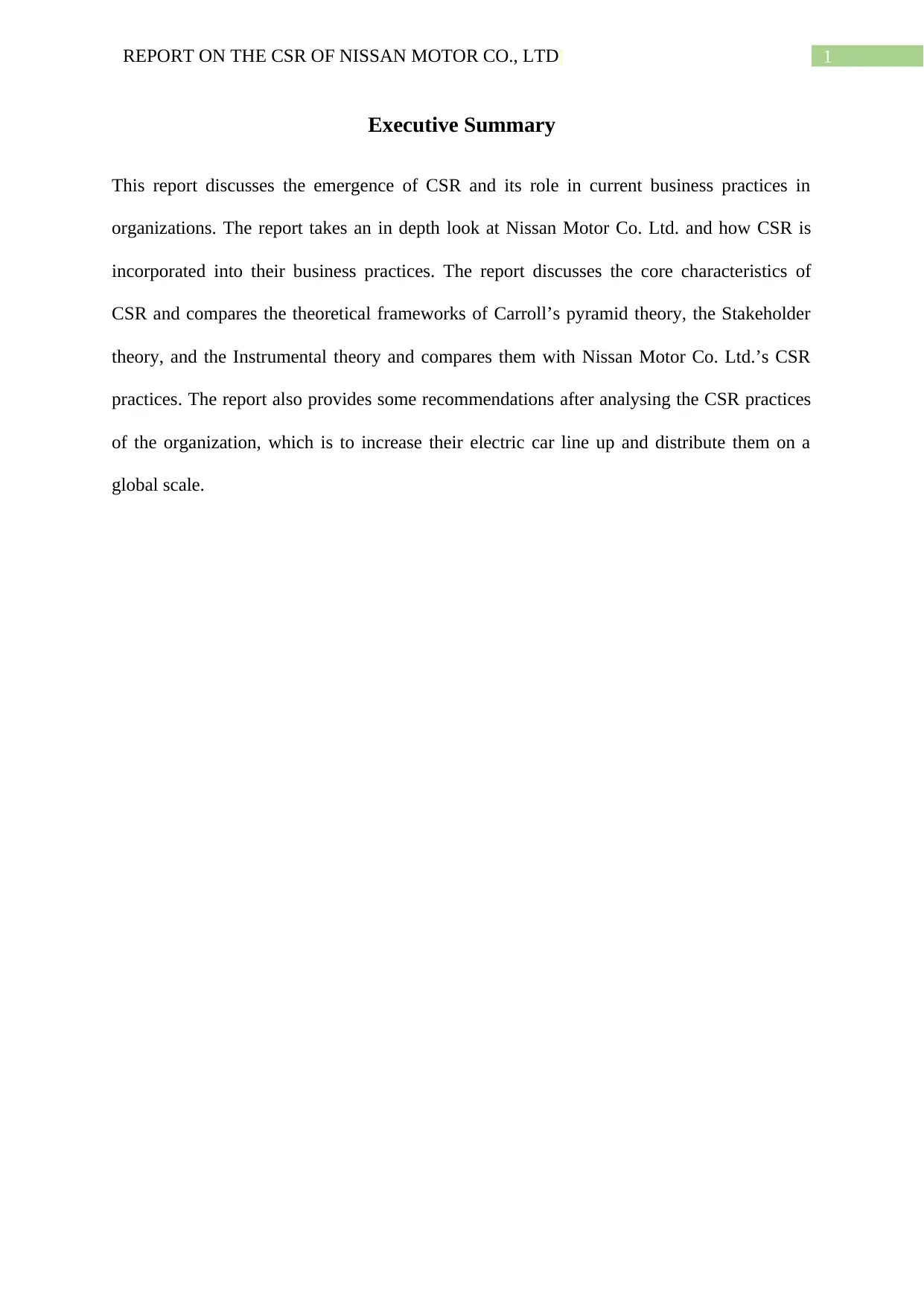
1REPORT ON THE CSR OF NISSAN MOTOR CO., LTD
Executive Summary
This report discusses the emergence of CSR and its role in current business practices in
organizations. The report takes an in depth look at Nissan Motor Co. Ltd. and how CSR is
incorporated into their business practices. The report discusses the core characteristics of
CSR and compares the theoretical frameworks of Carroll’s pyramid theory, the Stakeholder
theory, and the Instrumental theory and compares them with Nissan Motor Co. Ltd.’s CSR
practices. The report also provides some recommendations after analysing the CSR practices
of the organization, which is to increase their electric car line up and distribute them on a
global scale.
Executive Summary
This report discusses the emergence of CSR and its role in current business practices in
organizations. The report takes an in depth look at Nissan Motor Co. Ltd. and how CSR is
incorporated into their business practices. The report discusses the core characteristics of
CSR and compares the theoretical frameworks of Carroll’s pyramid theory, the Stakeholder
theory, and the Instrumental theory and compares them with Nissan Motor Co. Ltd.’s CSR
practices. The report also provides some recommendations after analysing the CSR practices
of the organization, which is to increase their electric car line up and distribute them on a
global scale.
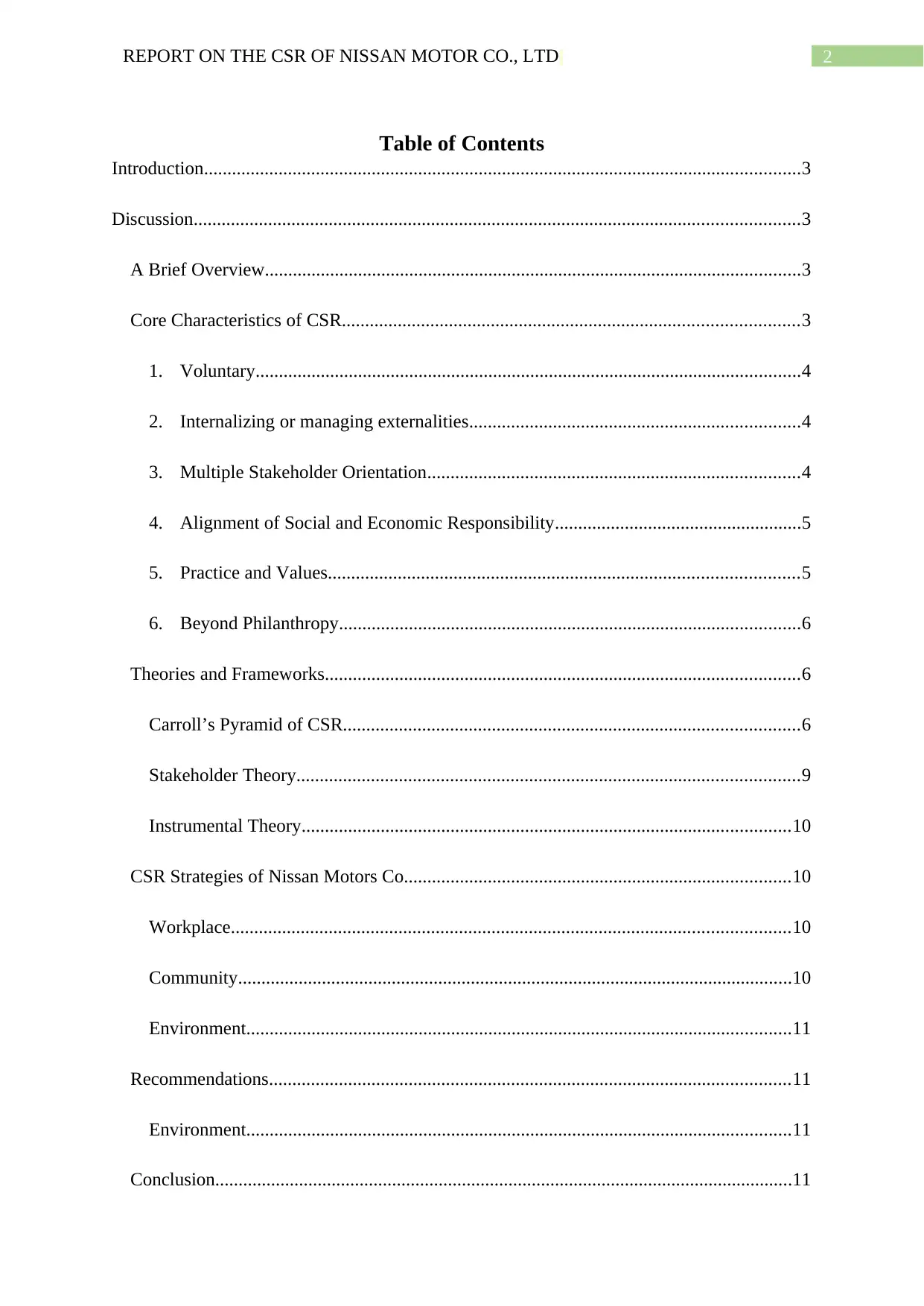
2REPORT ON THE CSR OF NISSAN MOTOR CO., LTD
Table of Contents
Introduction................................................................................................................................3
Discussion..................................................................................................................................3
A Brief Overview...................................................................................................................3
Core Characteristics of CSR..................................................................................................3
1. Voluntary.....................................................................................................................4
2. Internalizing or managing externalities.......................................................................4
3. Multiple Stakeholder Orientation................................................................................4
4. Alignment of Social and Economic Responsibility.....................................................5
5. Practice and Values.....................................................................................................5
6. Beyond Philanthropy...................................................................................................6
Theories and Frameworks......................................................................................................6
Carroll’s Pyramid of CSR..................................................................................................6
Stakeholder Theory............................................................................................................9
Instrumental Theory.........................................................................................................10
CSR Strategies of Nissan Motors Co...................................................................................10
Workplace........................................................................................................................10
Community.......................................................................................................................10
Environment.....................................................................................................................11
Recommendations................................................................................................................11
Environment.....................................................................................................................11
Conclusion............................................................................................................................11
Table of Contents
Introduction................................................................................................................................3
Discussion..................................................................................................................................3
A Brief Overview...................................................................................................................3
Core Characteristics of CSR..................................................................................................3
1. Voluntary.....................................................................................................................4
2. Internalizing or managing externalities.......................................................................4
3. Multiple Stakeholder Orientation................................................................................4
4. Alignment of Social and Economic Responsibility.....................................................5
5. Practice and Values.....................................................................................................5
6. Beyond Philanthropy...................................................................................................6
Theories and Frameworks......................................................................................................6
Carroll’s Pyramid of CSR..................................................................................................6
Stakeholder Theory............................................................................................................9
Instrumental Theory.........................................................................................................10
CSR Strategies of Nissan Motors Co...................................................................................10
Workplace........................................................................................................................10
Community.......................................................................................................................10
Environment.....................................................................................................................11
Recommendations................................................................................................................11
Environment.....................................................................................................................11
Conclusion............................................................................................................................11
⊘ This is a preview!⊘
Do you want full access?
Subscribe today to unlock all pages.

Trusted by 1+ million students worldwide

3REPORT ON THE CSR OF NISSAN MOTOR CO., LTD
References................................................................................................................................13
References................................................................................................................................13
Paraphrase This Document
Need a fresh take? Get an instant paraphrase of this document with our AI Paraphraser
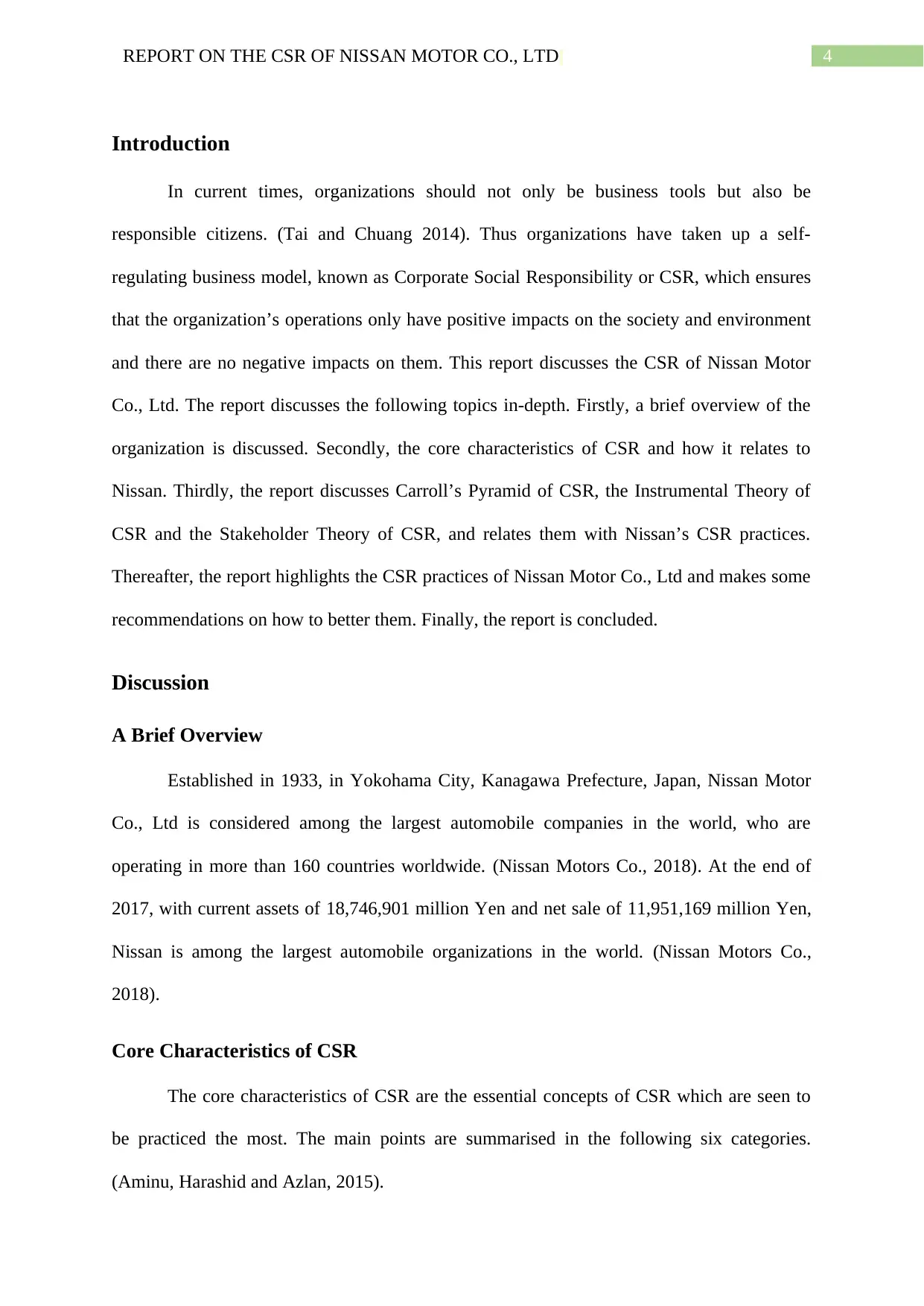
4REPORT ON THE CSR OF NISSAN MOTOR CO., LTD
Introduction
In current times, organizations should not only be business tools but also be
responsible citizens. (Tai and Chuang 2014). Thus organizations have taken up a self-
regulating business model, known as Corporate Social Responsibility or CSR, which ensures
that the organization’s operations only have positive impacts on the society and environment
and there are no negative impacts on them. This report discusses the CSR of Nissan Motor
Co., Ltd. The report discusses the following topics in-depth. Firstly, a brief overview of the
organization is discussed. Secondly, the core characteristics of CSR and how it relates to
Nissan. Thirdly, the report discusses Carroll’s Pyramid of CSR, the Instrumental Theory of
CSR and the Stakeholder Theory of CSR, and relates them with Nissan’s CSR practices.
Thereafter, the report highlights the CSR practices of Nissan Motor Co., Ltd and makes some
recommendations on how to better them. Finally, the report is concluded.
Discussion
A Brief Overview
Established in 1933, in Yokohama City, Kanagawa Prefecture, Japan, Nissan Motor
Co., Ltd is considered among the largest automobile companies in the world, who are
operating in more than 160 countries worldwide. (Nissan Motors Co., 2018). At the end of
2017, with current assets of 18,746,901 million Yen and net sale of 11,951,169 million Yen,
Nissan is among the largest automobile organizations in the world. (Nissan Motors Co.,
2018).
Core Characteristics of CSR
The core characteristics of CSR are the essential concepts of CSR which are seen to
be practiced the most. The main points are summarised in the following six categories.
(Aminu, Harashid and Azlan, 2015).
Introduction
In current times, organizations should not only be business tools but also be
responsible citizens. (Tai and Chuang 2014). Thus organizations have taken up a self-
regulating business model, known as Corporate Social Responsibility or CSR, which ensures
that the organization’s operations only have positive impacts on the society and environment
and there are no negative impacts on them. This report discusses the CSR of Nissan Motor
Co., Ltd. The report discusses the following topics in-depth. Firstly, a brief overview of the
organization is discussed. Secondly, the core characteristics of CSR and how it relates to
Nissan. Thirdly, the report discusses Carroll’s Pyramid of CSR, the Instrumental Theory of
CSR and the Stakeholder Theory of CSR, and relates them with Nissan’s CSR practices.
Thereafter, the report highlights the CSR practices of Nissan Motor Co., Ltd and makes some
recommendations on how to better them. Finally, the report is concluded.
Discussion
A Brief Overview
Established in 1933, in Yokohama City, Kanagawa Prefecture, Japan, Nissan Motor
Co., Ltd is considered among the largest automobile companies in the world, who are
operating in more than 160 countries worldwide. (Nissan Motors Co., 2018). At the end of
2017, with current assets of 18,746,901 million Yen and net sale of 11,951,169 million Yen,
Nissan is among the largest automobile organizations in the world. (Nissan Motors Co.,
2018).
Core Characteristics of CSR
The core characteristics of CSR are the essential concepts of CSR which are seen to
be practiced the most. The main points are summarised in the following six categories.
(Aminu, Harashid and Azlan, 2015).
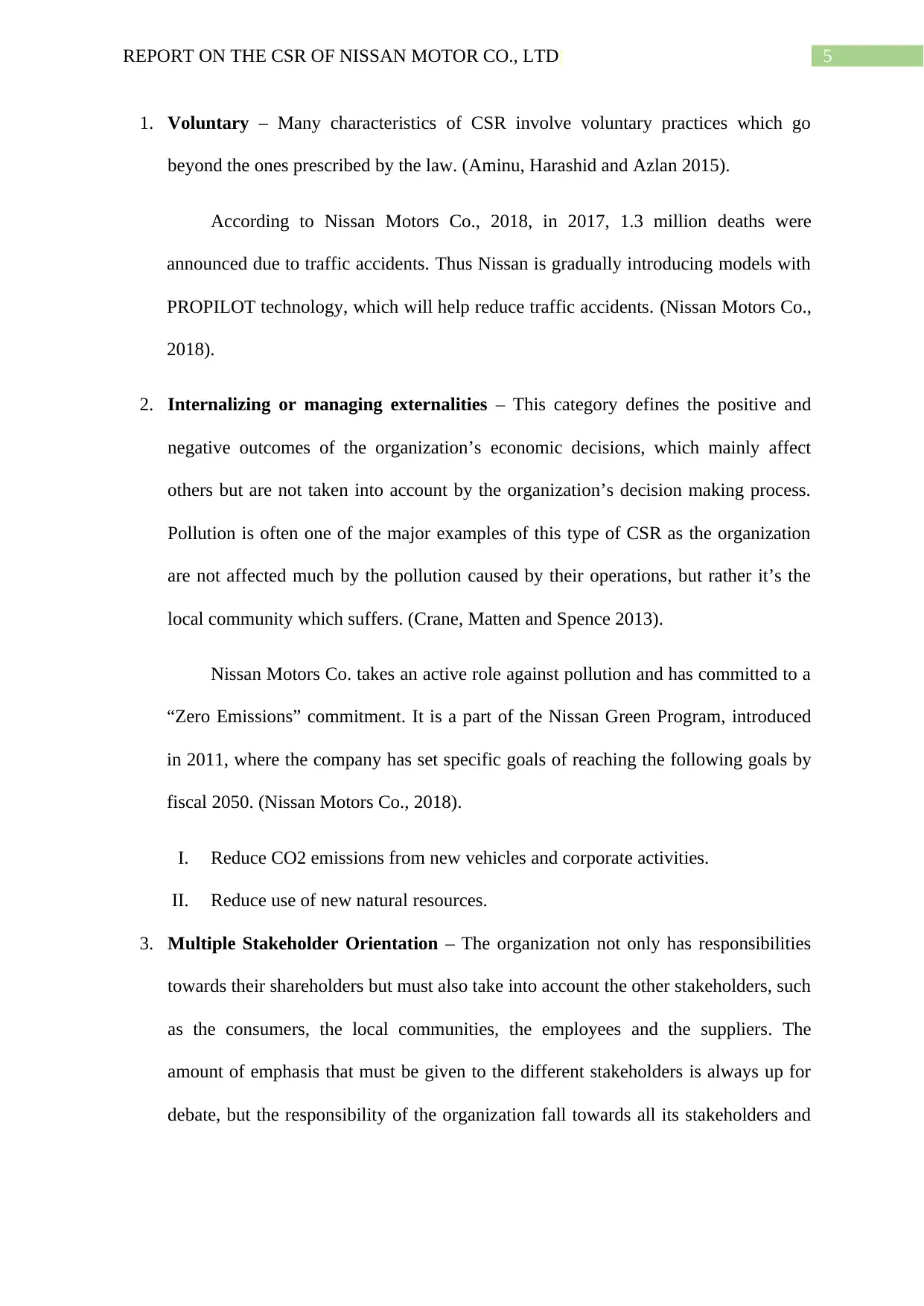
5REPORT ON THE CSR OF NISSAN MOTOR CO., LTD
1. Voluntary – Many characteristics of CSR involve voluntary practices which go
beyond the ones prescribed by the law. (Aminu, Harashid and Azlan 2015).
According to Nissan Motors Co., 2018, in 2017, 1.3 million deaths were
announced due to traffic accidents. Thus Nissan is gradually introducing models with
PROPILOT technology, which will help reduce traffic accidents. (Nissan Motors Co.,
2018).
2. Internalizing or managing externalities – This category defines the positive and
negative outcomes of the organization’s economic decisions, which mainly affect
others but are not taken into account by the organization’s decision making process.
Pollution is often one of the major examples of this type of CSR as the organization
are not affected much by the pollution caused by their operations, but rather it’s the
local community which suffers. (Crane, Matten and Spence 2013).
Nissan Motors Co. takes an active role against pollution and has committed to a
“Zero Emissions” commitment. It is a part of the Nissan Green Program, introduced
in 2011, where the company has set specific goals of reaching the following goals by
fiscal 2050. (Nissan Motors Co., 2018).
I. Reduce CO2 emissions from new vehicles and corporate activities.
II. Reduce use of new natural resources.
3. Multiple Stakeholder Orientation – The organization not only has responsibilities
towards their shareholders but must also take into account the other stakeholders, such
as the consumers, the local communities, the employees and the suppliers. The
amount of emphasis that must be given to the different stakeholders is always up for
debate, but the responsibility of the organization fall towards all its stakeholders and
1. Voluntary – Many characteristics of CSR involve voluntary practices which go
beyond the ones prescribed by the law. (Aminu, Harashid and Azlan 2015).
According to Nissan Motors Co., 2018, in 2017, 1.3 million deaths were
announced due to traffic accidents. Thus Nissan is gradually introducing models with
PROPILOT technology, which will help reduce traffic accidents. (Nissan Motors Co.,
2018).
2. Internalizing or managing externalities – This category defines the positive and
negative outcomes of the organization’s economic decisions, which mainly affect
others but are not taken into account by the organization’s decision making process.
Pollution is often one of the major examples of this type of CSR as the organization
are not affected much by the pollution caused by their operations, but rather it’s the
local community which suffers. (Crane, Matten and Spence 2013).
Nissan Motors Co. takes an active role against pollution and has committed to a
“Zero Emissions” commitment. It is a part of the Nissan Green Program, introduced
in 2011, where the company has set specific goals of reaching the following goals by
fiscal 2050. (Nissan Motors Co., 2018).
I. Reduce CO2 emissions from new vehicles and corporate activities.
II. Reduce use of new natural resources.
3. Multiple Stakeholder Orientation – The organization not only has responsibilities
towards their shareholders but must also take into account the other stakeholders, such
as the consumers, the local communities, the employees and the suppliers. The
amount of emphasis that must be given to the different stakeholders is always up for
debate, but the responsibility of the organization fall towards all its stakeholders and
⊘ This is a preview!⊘
Do you want full access?
Subscribe today to unlock all pages.

Trusted by 1+ million students worldwide
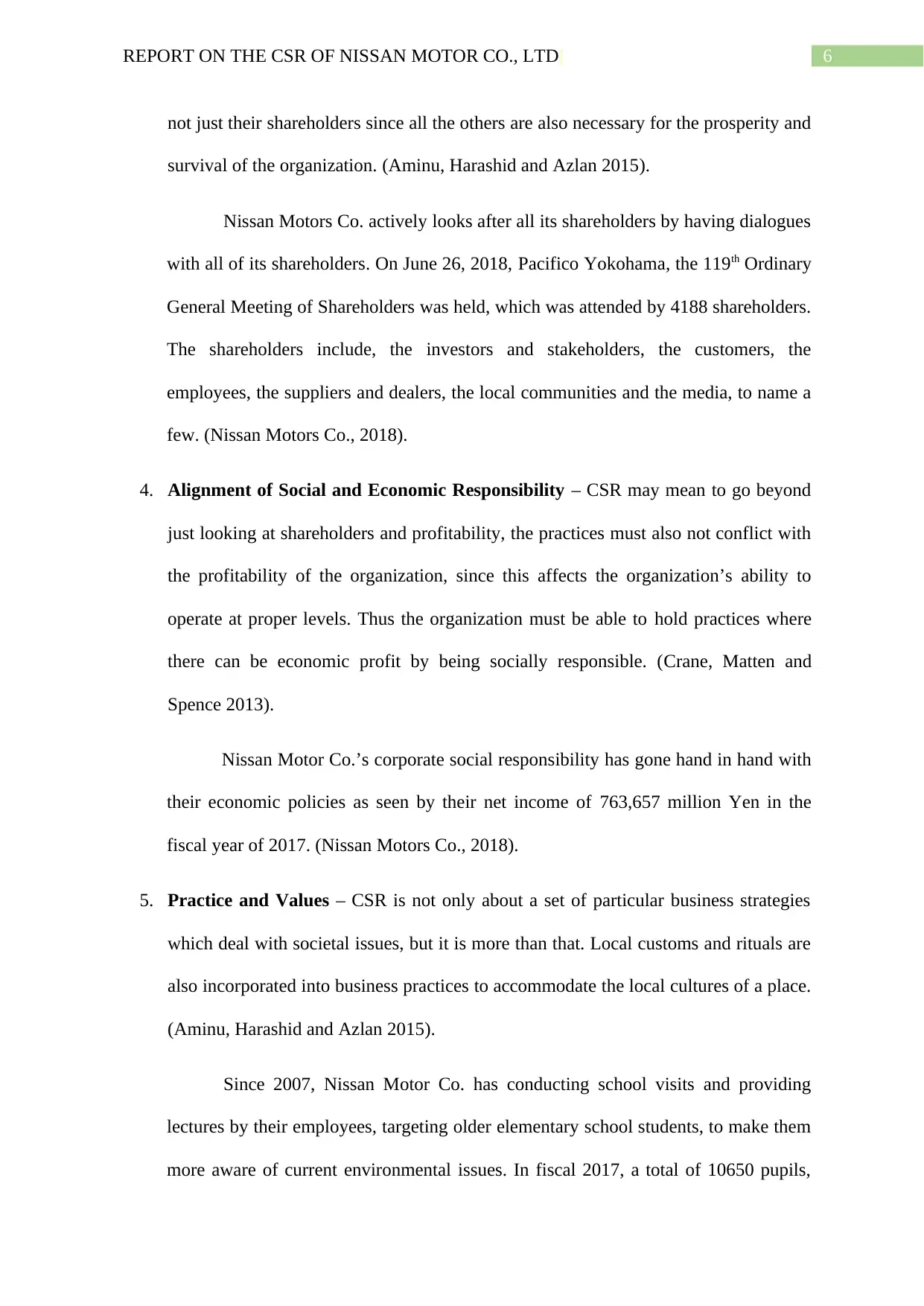
6REPORT ON THE CSR OF NISSAN MOTOR CO., LTD
not just their shareholders since all the others are also necessary for the prosperity and
survival of the organization. (Aminu, Harashid and Azlan 2015).
Nissan Motors Co. actively looks after all its shareholders by having dialogues
with all of its shareholders. On June 26, 2018, Pacifico Yokohama, the 119th Ordinary
General Meeting of Shareholders was held, which was attended by 4188 shareholders.
The shareholders include, the investors and stakeholders, the customers, the
employees, the suppliers and dealers, the local communities and the media, to name a
few. (Nissan Motors Co., 2018).
4. Alignment of Social and Economic Responsibility – CSR may mean to go beyond
just looking at shareholders and profitability, the practices must also not conflict with
the profitability of the organization, since this affects the organization’s ability to
operate at proper levels. Thus the organization must be able to hold practices where
there can be economic profit by being socially responsible. (Crane, Matten and
Spence 2013).
Nissan Motor Co.’s corporate social responsibility has gone hand in hand with
their economic policies as seen by their net income of 763,657 million Yen in the
fiscal year of 2017. (Nissan Motors Co., 2018).
5. Practice and Values – CSR is not only about a set of particular business strategies
which deal with societal issues, but it is more than that. Local customs and rituals are
also incorporated into business practices to accommodate the local cultures of a place.
(Aminu, Harashid and Azlan 2015).
Since 2007, Nissan Motor Co. has conducting school visits and providing
lectures by their employees, targeting older elementary school students, to make them
more aware of current environmental issues. In fiscal 2017, a total of 10650 pupils,
not just their shareholders since all the others are also necessary for the prosperity and
survival of the organization. (Aminu, Harashid and Azlan 2015).
Nissan Motors Co. actively looks after all its shareholders by having dialogues
with all of its shareholders. On June 26, 2018, Pacifico Yokohama, the 119th Ordinary
General Meeting of Shareholders was held, which was attended by 4188 shareholders.
The shareholders include, the investors and stakeholders, the customers, the
employees, the suppliers and dealers, the local communities and the media, to name a
few. (Nissan Motors Co., 2018).
4. Alignment of Social and Economic Responsibility – CSR may mean to go beyond
just looking at shareholders and profitability, the practices must also not conflict with
the profitability of the organization, since this affects the organization’s ability to
operate at proper levels. Thus the organization must be able to hold practices where
there can be economic profit by being socially responsible. (Crane, Matten and
Spence 2013).
Nissan Motor Co.’s corporate social responsibility has gone hand in hand with
their economic policies as seen by their net income of 763,657 million Yen in the
fiscal year of 2017. (Nissan Motors Co., 2018).
5. Practice and Values – CSR is not only about a set of particular business strategies
which deal with societal issues, but it is more than that. Local customs and rituals are
also incorporated into business practices to accommodate the local cultures of a place.
(Aminu, Harashid and Azlan 2015).
Since 2007, Nissan Motor Co. has conducting school visits and providing
lectures by their employees, targeting older elementary school students, to make them
more aware of current environmental issues. In fiscal 2017, a total of 10650 pupils,
Paraphrase This Document
Need a fresh take? Get an instant paraphrase of this document with our AI Paraphraser
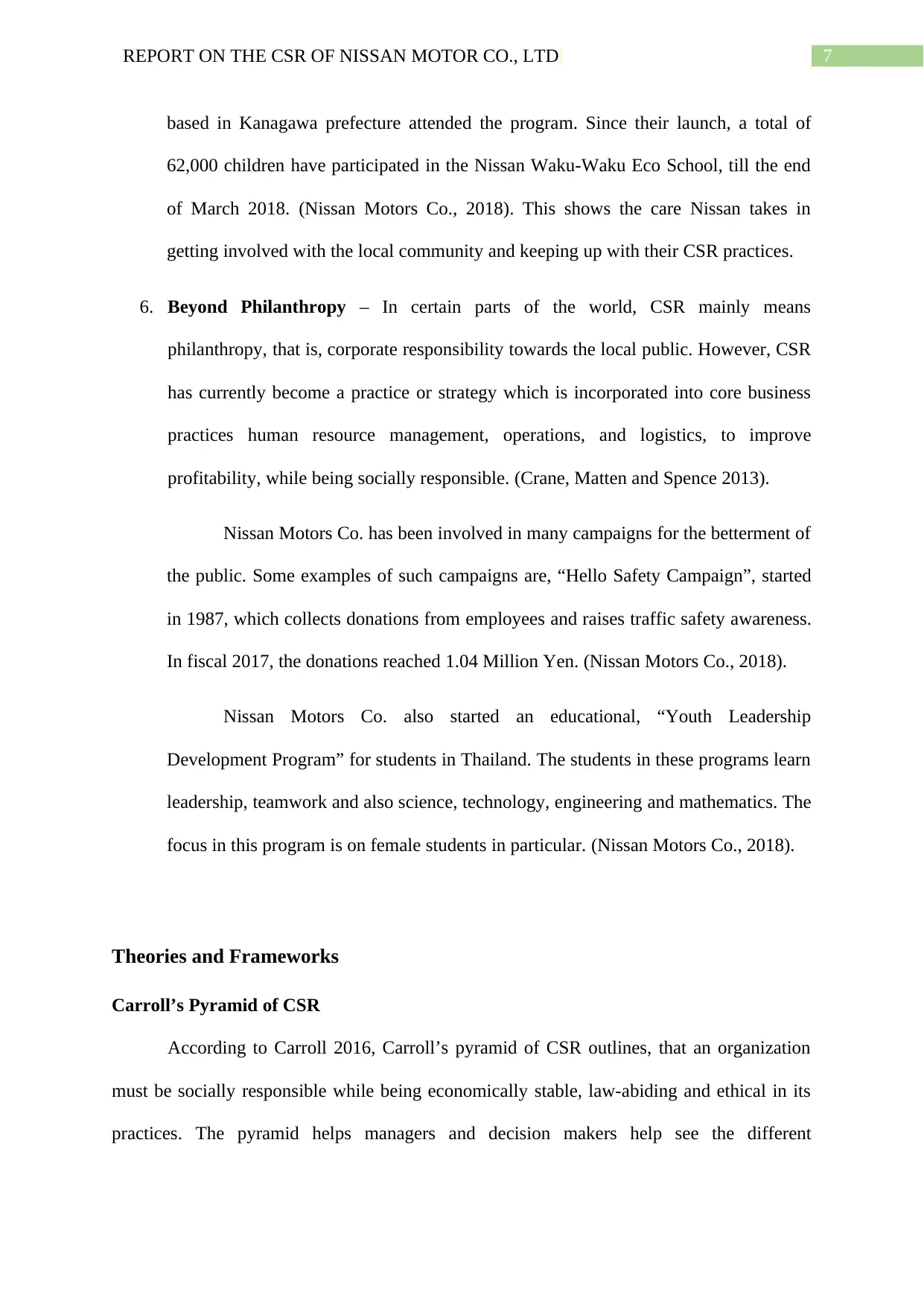
7REPORT ON THE CSR OF NISSAN MOTOR CO., LTD
based in Kanagawa prefecture attended the program. Since their launch, a total of
62,000 children have participated in the Nissan Waku-Waku Eco School, till the end
of March 2018. (Nissan Motors Co., 2018). This shows the care Nissan takes in
getting involved with the local community and keeping up with their CSR practices.
6. Beyond Philanthropy – In certain parts of the world, CSR mainly means
philanthropy, that is, corporate responsibility towards the local public. However, CSR
has currently become a practice or strategy which is incorporated into core business
practices human resource management, operations, and logistics, to improve
profitability, while being socially responsible. (Crane, Matten and Spence 2013).
Nissan Motors Co. has been involved in many campaigns for the betterment of
the public. Some examples of such campaigns are, “Hello Safety Campaign”, started
in 1987, which collects donations from employees and raises traffic safety awareness.
In fiscal 2017, the donations reached 1.04 Million Yen. (Nissan Motors Co., 2018).
Nissan Motors Co. also started an educational, “Youth Leadership
Development Program” for students in Thailand. The students in these programs learn
leadership, teamwork and also science, technology, engineering and mathematics. The
focus in this program is on female students in particular. (Nissan Motors Co., 2018).
Theories and Frameworks
Carroll’s Pyramid of CSR
According to Carroll 2016, Carroll’s pyramid of CSR outlines, that an organization
must be socially responsible while being economically stable, law-abiding and ethical in its
practices. The pyramid helps managers and decision makers help see the different
based in Kanagawa prefecture attended the program. Since their launch, a total of
62,000 children have participated in the Nissan Waku-Waku Eco School, till the end
of March 2018. (Nissan Motors Co., 2018). This shows the care Nissan takes in
getting involved with the local community and keeping up with their CSR practices.
6. Beyond Philanthropy – In certain parts of the world, CSR mainly means
philanthropy, that is, corporate responsibility towards the local public. However, CSR
has currently become a practice or strategy which is incorporated into core business
practices human resource management, operations, and logistics, to improve
profitability, while being socially responsible. (Crane, Matten and Spence 2013).
Nissan Motors Co. has been involved in many campaigns for the betterment of
the public. Some examples of such campaigns are, “Hello Safety Campaign”, started
in 1987, which collects donations from employees and raises traffic safety awareness.
In fiscal 2017, the donations reached 1.04 Million Yen. (Nissan Motors Co., 2018).
Nissan Motors Co. also started an educational, “Youth Leadership
Development Program” for students in Thailand. The students in these programs learn
leadership, teamwork and also science, technology, engineering and mathematics. The
focus in this program is on female students in particular. (Nissan Motors Co., 2018).
Theories and Frameworks
Carroll’s Pyramid of CSR
According to Carroll 2016, Carroll’s pyramid of CSR outlines, that an organization
must be socially responsible while being economically stable, law-abiding and ethical in its
practices. The pyramid helps managers and decision makers help see the different
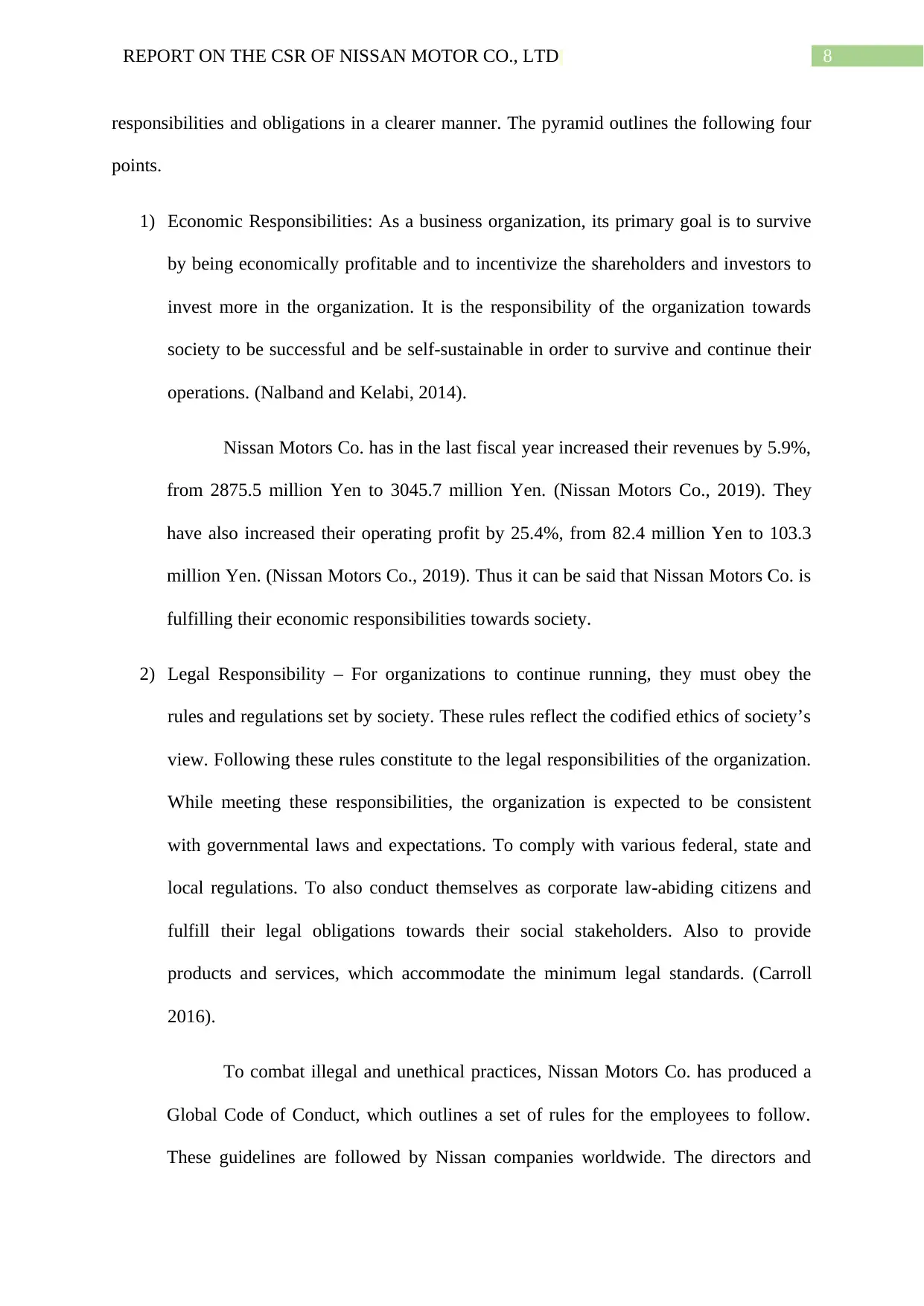
8REPORT ON THE CSR OF NISSAN MOTOR CO., LTD
responsibilities and obligations in a clearer manner. The pyramid outlines the following four
points.
1) Economic Responsibilities: As a business organization, its primary goal is to survive
by being economically profitable and to incentivize the shareholders and investors to
invest more in the organization. It is the responsibility of the organization towards
society to be successful and be self-sustainable in order to survive and continue their
operations. (Nalband and Kelabi, 2014).
Nissan Motors Co. has in the last fiscal year increased their revenues by 5.9%,
from 2875.5 million Yen to 3045.7 million Yen. (Nissan Motors Co., 2019). They
have also increased their operating profit by 25.4%, from 82.4 million Yen to 103.3
million Yen. (Nissan Motors Co., 2019). Thus it can be said that Nissan Motors Co. is
fulfilling their economic responsibilities towards society.
2) Legal Responsibility – For organizations to continue running, they must obey the
rules and regulations set by society. These rules reflect the codified ethics of society’s
view. Following these rules constitute to the legal responsibilities of the organization.
While meeting these responsibilities, the organization is expected to be consistent
with governmental laws and expectations. To comply with various federal, state and
local regulations. To also conduct themselves as corporate law-abiding citizens and
fulfill their legal obligations towards their social stakeholders. Also to provide
products and services, which accommodate the minimum legal standards. (Carroll
2016).
To combat illegal and unethical practices, Nissan Motors Co. has produced a
Global Code of Conduct, which outlines a set of rules for the employees to follow.
These guidelines are followed by Nissan companies worldwide. The directors and
responsibilities and obligations in a clearer manner. The pyramid outlines the following four
points.
1) Economic Responsibilities: As a business organization, its primary goal is to survive
by being economically profitable and to incentivize the shareholders and investors to
invest more in the organization. It is the responsibility of the organization towards
society to be successful and be self-sustainable in order to survive and continue their
operations. (Nalband and Kelabi, 2014).
Nissan Motors Co. has in the last fiscal year increased their revenues by 5.9%,
from 2875.5 million Yen to 3045.7 million Yen. (Nissan Motors Co., 2019). They
have also increased their operating profit by 25.4%, from 82.4 million Yen to 103.3
million Yen. (Nissan Motors Co., 2019). Thus it can be said that Nissan Motors Co. is
fulfilling their economic responsibilities towards society.
2) Legal Responsibility – For organizations to continue running, they must obey the
rules and regulations set by society. These rules reflect the codified ethics of society’s
view. Following these rules constitute to the legal responsibilities of the organization.
While meeting these responsibilities, the organization is expected to be consistent
with governmental laws and expectations. To comply with various federal, state and
local regulations. To also conduct themselves as corporate law-abiding citizens and
fulfill their legal obligations towards their social stakeholders. Also to provide
products and services, which accommodate the minimum legal standards. (Carroll
2016).
To combat illegal and unethical practices, Nissan Motors Co. has produced a
Global Code of Conduct, which outlines a set of rules for the employees to follow.
These guidelines are followed by Nissan companies worldwide. The directors and
⊘ This is a preview!⊘
Do you want full access?
Subscribe today to unlock all pages.

Trusted by 1+ million students worldwide
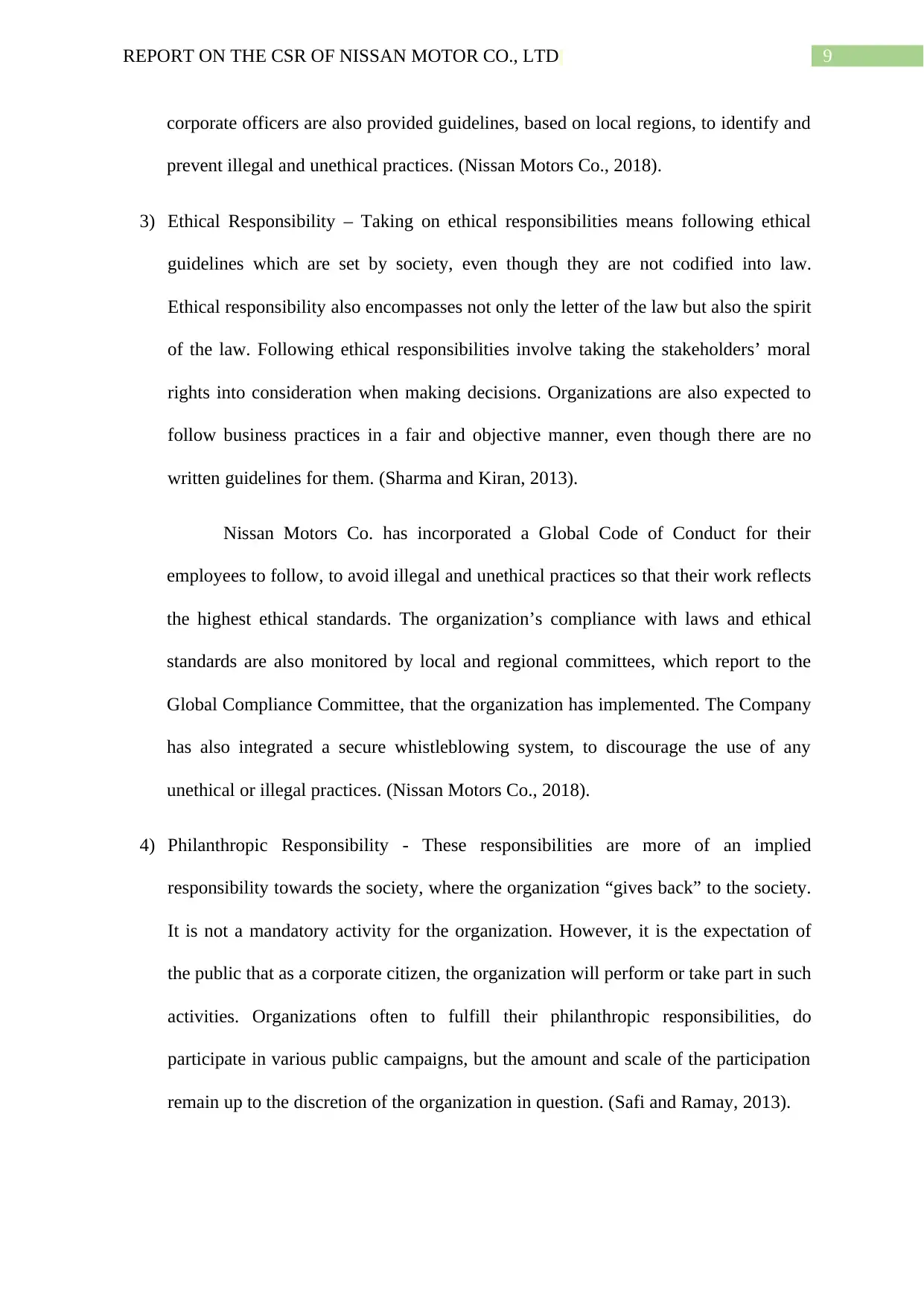
9REPORT ON THE CSR OF NISSAN MOTOR CO., LTD
corporate officers are also provided guidelines, based on local regions, to identify and
prevent illegal and unethical practices. (Nissan Motors Co., 2018).
3) Ethical Responsibility – Taking on ethical responsibilities means following ethical
guidelines which are set by society, even though they are not codified into law.
Ethical responsibility also encompasses not only the letter of the law but also the spirit
of the law. Following ethical responsibilities involve taking the stakeholders’ moral
rights into consideration when making decisions. Organizations are also expected to
follow business practices in a fair and objective manner, even though there are no
written guidelines for them. (Sharma and Kiran, 2013).
Nissan Motors Co. has incorporated a Global Code of Conduct for their
employees to follow, to avoid illegal and unethical practices so that their work reflects
the highest ethical standards. The organization’s compliance with laws and ethical
standards are also monitored by local and regional committees, which report to the
Global Compliance Committee, that the organization has implemented. The Company
has also integrated a secure whistleblowing system, to discourage the use of any
unethical or illegal practices. (Nissan Motors Co., 2018).
4) Philanthropic Responsibility - These responsibilities are more of an implied
responsibility towards the society, where the organization “gives back” to the society.
It is not a mandatory activity for the organization. However, it is the expectation of
the public that as a corporate citizen, the organization will perform or take part in such
activities. Organizations often to fulfill their philanthropic responsibilities, do
participate in various public campaigns, but the amount and scale of the participation
remain up to the discretion of the organization in question. (Safi and Ramay, 2013).
corporate officers are also provided guidelines, based on local regions, to identify and
prevent illegal and unethical practices. (Nissan Motors Co., 2018).
3) Ethical Responsibility – Taking on ethical responsibilities means following ethical
guidelines which are set by society, even though they are not codified into law.
Ethical responsibility also encompasses not only the letter of the law but also the spirit
of the law. Following ethical responsibilities involve taking the stakeholders’ moral
rights into consideration when making decisions. Organizations are also expected to
follow business practices in a fair and objective manner, even though there are no
written guidelines for them. (Sharma and Kiran, 2013).
Nissan Motors Co. has incorporated a Global Code of Conduct for their
employees to follow, to avoid illegal and unethical practices so that their work reflects
the highest ethical standards. The organization’s compliance with laws and ethical
standards are also monitored by local and regional committees, which report to the
Global Compliance Committee, that the organization has implemented. The Company
has also integrated a secure whistleblowing system, to discourage the use of any
unethical or illegal practices. (Nissan Motors Co., 2018).
4) Philanthropic Responsibility - These responsibilities are more of an implied
responsibility towards the society, where the organization “gives back” to the society.
It is not a mandatory activity for the organization. However, it is the expectation of
the public that as a corporate citizen, the organization will perform or take part in such
activities. Organizations often to fulfill their philanthropic responsibilities, do
participate in various public campaigns, but the amount and scale of the participation
remain up to the discretion of the organization in question. (Safi and Ramay, 2013).
Paraphrase This Document
Need a fresh take? Get an instant paraphrase of this document with our AI Paraphraser
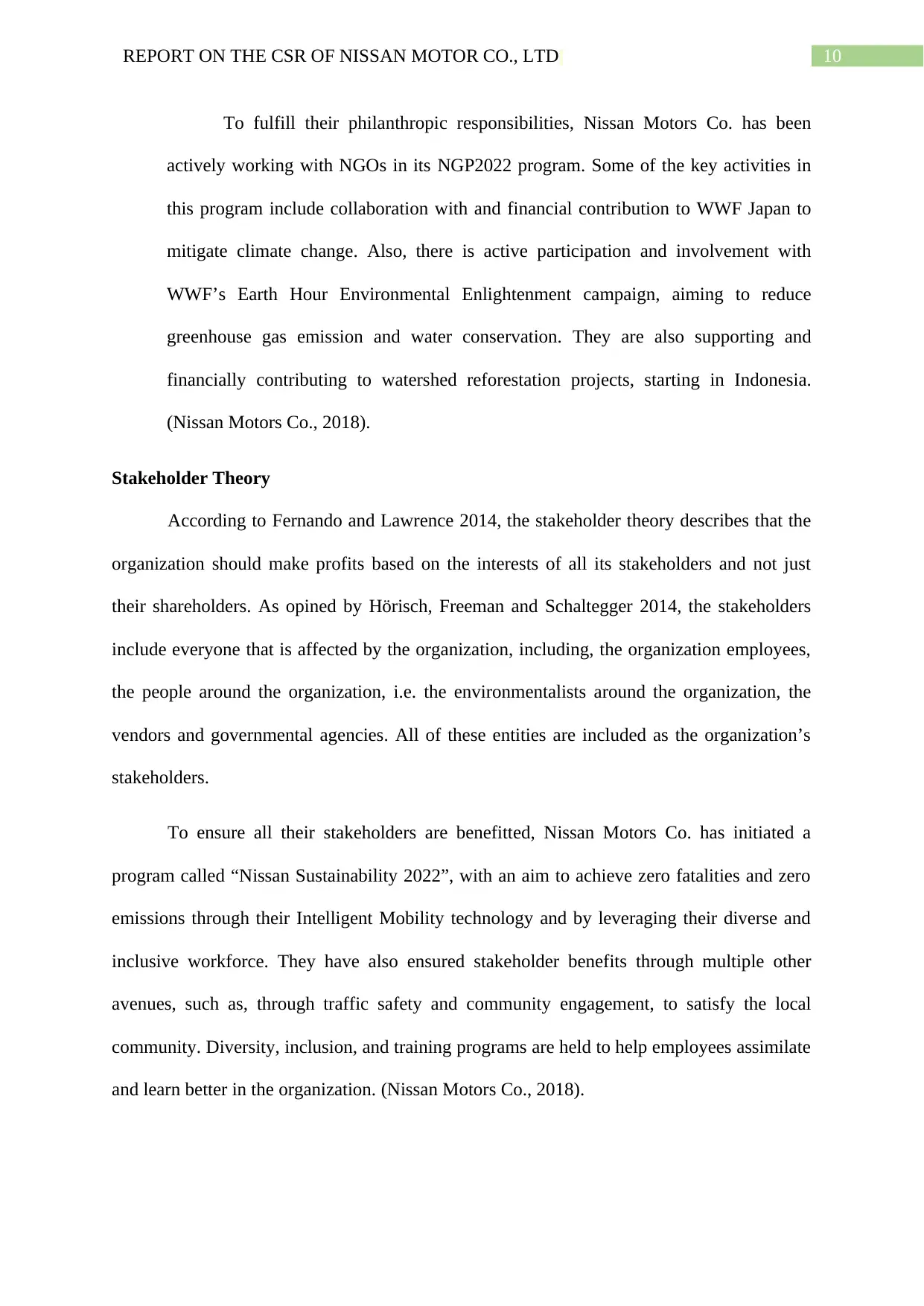
10REPORT ON THE CSR OF NISSAN MOTOR CO., LTD
To fulfill their philanthropic responsibilities, Nissan Motors Co. has been
actively working with NGOs in its NGP2022 program. Some of the key activities in
this program include collaboration with and financial contribution to WWF Japan to
mitigate climate change. Also, there is active participation and involvement with
WWF’s Earth Hour Environmental Enlightenment campaign, aiming to reduce
greenhouse gas emission and water conservation. They are also supporting and
financially contributing to watershed reforestation projects, starting in Indonesia.
(Nissan Motors Co., 2018).
Stakeholder Theory
According to Fernando and Lawrence 2014, the stakeholder theory describes that the
organization should make profits based on the interests of all its stakeholders and not just
their shareholders. As opined by Hörisch, Freeman and Schaltegger 2014, the stakeholders
include everyone that is affected by the organization, including, the organization employees,
the people around the organization, i.e. the environmentalists around the organization, the
vendors and governmental agencies. All of these entities are included as the organization’s
stakeholders.
To ensure all their stakeholders are benefitted, Nissan Motors Co. has initiated a
program called “Nissan Sustainability 2022”, with an aim to achieve zero fatalities and zero
emissions through their Intelligent Mobility technology and by leveraging their diverse and
inclusive workforce. They have also ensured stakeholder benefits through multiple other
avenues, such as, through traffic safety and community engagement, to satisfy the local
community. Diversity, inclusion, and training programs are held to help employees assimilate
and learn better in the organization. (Nissan Motors Co., 2018).
To fulfill their philanthropic responsibilities, Nissan Motors Co. has been
actively working with NGOs in its NGP2022 program. Some of the key activities in
this program include collaboration with and financial contribution to WWF Japan to
mitigate climate change. Also, there is active participation and involvement with
WWF’s Earth Hour Environmental Enlightenment campaign, aiming to reduce
greenhouse gas emission and water conservation. They are also supporting and
financially contributing to watershed reforestation projects, starting in Indonesia.
(Nissan Motors Co., 2018).
Stakeholder Theory
According to Fernando and Lawrence 2014, the stakeholder theory describes that the
organization should make profits based on the interests of all its stakeholders and not just
their shareholders. As opined by Hörisch, Freeman and Schaltegger 2014, the stakeholders
include everyone that is affected by the organization, including, the organization employees,
the people around the organization, i.e. the environmentalists around the organization, the
vendors and governmental agencies. All of these entities are included as the organization’s
stakeholders.
To ensure all their stakeholders are benefitted, Nissan Motors Co. has initiated a
program called “Nissan Sustainability 2022”, with an aim to achieve zero fatalities and zero
emissions through their Intelligent Mobility technology and by leveraging their diverse and
inclusive workforce. They have also ensured stakeholder benefits through multiple other
avenues, such as, through traffic safety and community engagement, to satisfy the local
community. Diversity, inclusion, and training programs are held to help employees assimilate
and learn better in the organization. (Nissan Motors Co., 2018).
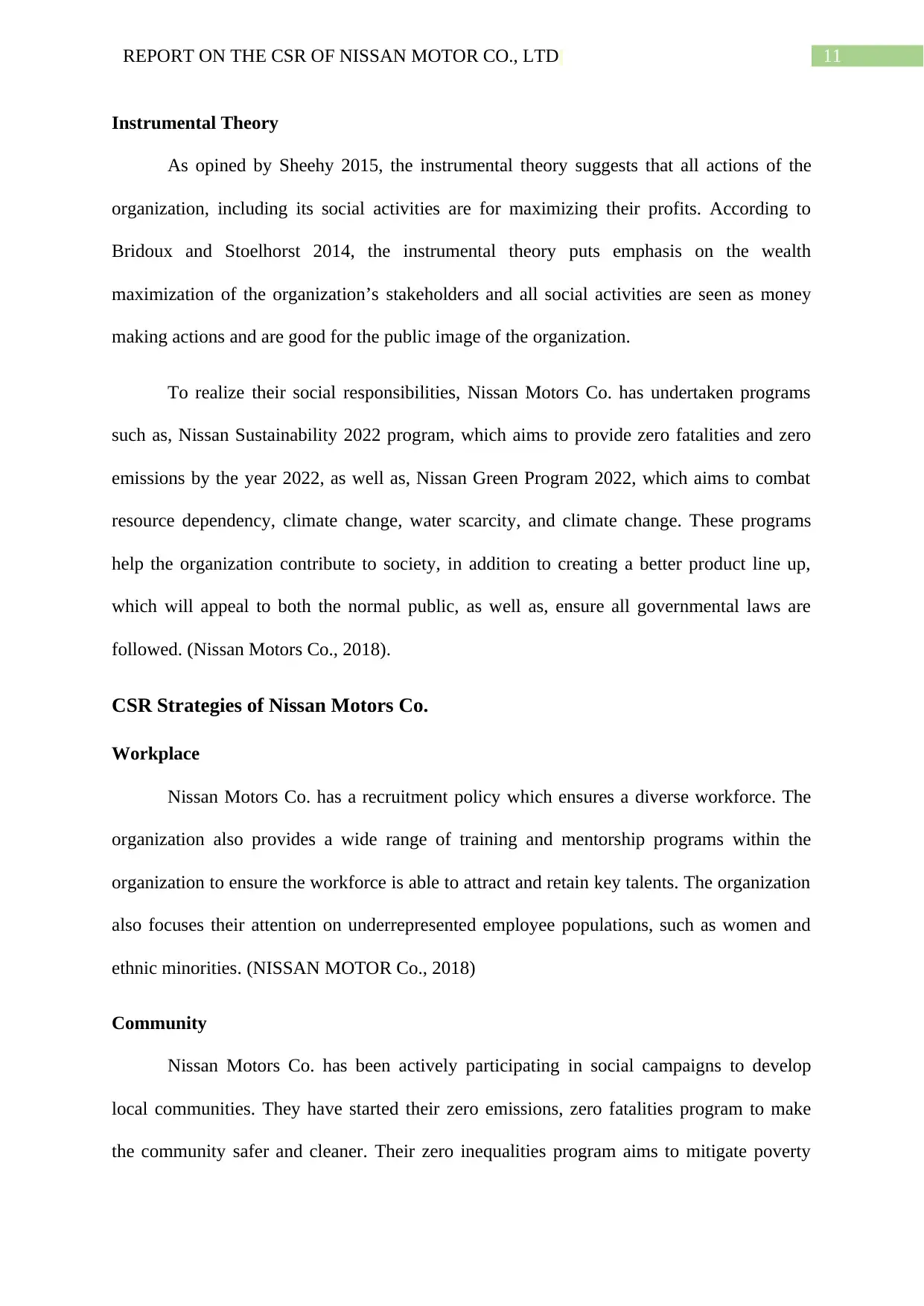
11REPORT ON THE CSR OF NISSAN MOTOR CO., LTD
Instrumental Theory
As opined by Sheehy 2015, the instrumental theory suggests that all actions of the
organization, including its social activities are for maximizing their profits. According to
Bridoux and Stoelhorst 2014, the instrumental theory puts emphasis on the wealth
maximization of the organization’s stakeholders and all social activities are seen as money
making actions and are good for the public image of the organization.
To realize their social responsibilities, Nissan Motors Co. has undertaken programs
such as, Nissan Sustainability 2022 program, which aims to provide zero fatalities and zero
emissions by the year 2022, as well as, Nissan Green Program 2022, which aims to combat
resource dependency, climate change, water scarcity, and climate change. These programs
help the organization contribute to society, in addition to creating a better product line up,
which will appeal to both the normal public, as well as, ensure all governmental laws are
followed. (Nissan Motors Co., 2018).
CSR Strategies of Nissan Motors Co.
Workplace
Nissan Motors Co. has a recruitment policy which ensures a diverse workforce. The
organization also provides a wide range of training and mentorship programs within the
organization to ensure the workforce is able to attract and retain key talents. The organization
also focuses their attention on underrepresented employee populations, such as women and
ethnic minorities. (NISSAN MOTOR Co., 2018)
Community
Nissan Motors Co. has been actively participating in social campaigns to develop
local communities. They have started their zero emissions, zero fatalities program to make
the community safer and cleaner. Their zero inequalities program aims to mitigate poverty
Instrumental Theory
As opined by Sheehy 2015, the instrumental theory suggests that all actions of the
organization, including its social activities are for maximizing their profits. According to
Bridoux and Stoelhorst 2014, the instrumental theory puts emphasis on the wealth
maximization of the organization’s stakeholders and all social activities are seen as money
making actions and are good for the public image of the organization.
To realize their social responsibilities, Nissan Motors Co. has undertaken programs
such as, Nissan Sustainability 2022 program, which aims to provide zero fatalities and zero
emissions by the year 2022, as well as, Nissan Green Program 2022, which aims to combat
resource dependency, climate change, water scarcity, and climate change. These programs
help the organization contribute to society, in addition to creating a better product line up,
which will appeal to both the normal public, as well as, ensure all governmental laws are
followed. (Nissan Motors Co., 2018).
CSR Strategies of Nissan Motors Co.
Workplace
Nissan Motors Co. has a recruitment policy which ensures a diverse workforce. The
organization also provides a wide range of training and mentorship programs within the
organization to ensure the workforce is able to attract and retain key talents. The organization
also focuses their attention on underrepresented employee populations, such as women and
ethnic minorities. (NISSAN MOTOR Co., 2018)
Community
Nissan Motors Co. has been actively participating in social campaigns to develop
local communities. They have started their zero emissions, zero fatalities program to make
the community safer and cleaner. Their zero inequalities program aims to mitigate poverty
⊘ This is a preview!⊘
Do you want full access?
Subscribe today to unlock all pages.

Trusted by 1+ million students worldwide
1 out of 17
Related Documents
Your All-in-One AI-Powered Toolkit for Academic Success.
+13062052269
info@desklib.com
Available 24*7 on WhatsApp / Email
![[object Object]](/_next/static/media/star-bottom.7253800d.svg)
Unlock your academic potential
Copyright © 2020–2025 A2Z Services. All Rights Reserved. Developed and managed by ZUCOL.





